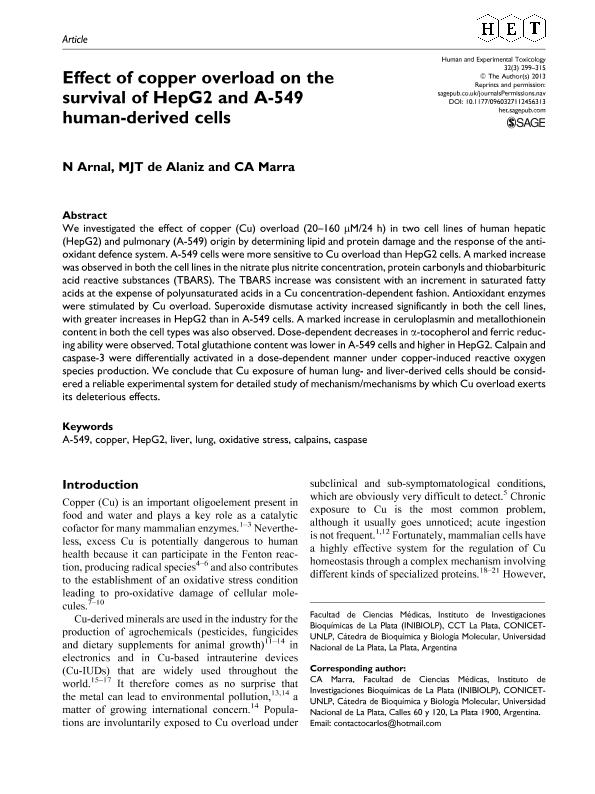Mostrar el registro sencillo del ítem
dc.contributor.author
Arnal, Nathalie

dc.contributor.author
de Alaniz, M. J. T.
dc.contributor.author
Marra, Carlos Alberto

dc.date.available
2015-10-07T20:38:26Z
dc.date.issued
2013-03
dc.identifier.citation
Arnal, Nathalie; de Alaniz, M. J. T.; Marra, Carlos Alberto; Effect of copper overload on the survival of HepG2 and A-549 human-derived cells; Sage Publications Ltd; Human and Experimental Toxicoloxy; 32; 3; 3-2013; 299-315
dc.identifier.issn
0960-3271
dc.identifier.uri
http://hdl.handle.net/11336/2403
dc.description.abstract
We investigated the effect of copper (Cu) overload (20-160 μM/24 h) in two cell lines of human hepatic (HepG2) and pulmonary (A-549) origin by determining lipid and protein damage and the response of the antioxidant defence system. A-549 cells were more sensitive to Cu overload than HepG2 cells. A marked increase was observed in both the cell lines in the nitrate plus nitrite concentration, protein carbonyls and thiobarbituric acid reactive substances (TBARS). The TBARS increase was consistent with an increment in saturated fatty acids at the expense of polyunsaturated acids in a Cu concentration-dependent fashion. Antioxidant enzymes were stimulated by Cu overload. Superoxide dismutase activity increased significantly in both the cell lines, with greater increases in HepG2 than in A-549 cells. A marked increase in ceruloplasmin and metallothionein content in both the cell types was also observed. Dose-dependent decreases in α-tocopherol and ferric reducing ability were observed. Total glutathione content was lower in A-549 cells and higher in HepG2. Calpain and caspase-3 were differentially activated in a dose-dependent manner under copper-induced reactive oxygen species production. We conclude that Cu exposure of human lung- and liver-derived cells should be considered a reliable experimental system for detailed study of mechanism/mechanisms by which Cu overload exerts its deleterious effects.
dc.format
application/pdf
dc.language.iso
eng
dc.publisher
Sage Publications Ltd

dc.rights
info:eu-repo/semantics/openAccess
dc.rights.uri
https://creativecommons.org/licenses/by-nc-sa/2.5/ar/
dc.subject
A-549
dc.subject
CALPAINS
dc.subject
CASPASE
dc.subject
COPPER
dc.subject
HEPG2
dc.subject
LIVER
dc.subject
LUNG
dc.subject
OXIDATIVE STRESS
dc.subject.classification
Bioquímica y Biología Molecular

dc.subject.classification
Ciencias Biológicas

dc.subject.classification
CIENCIAS NATURALES Y EXACTAS

dc.title
Effect of copper overload on the survival of HepG2 and A-549 human-derived cells
dc.type
info:eu-repo/semantics/article
dc.type
info:ar-repo/semantics/artículo
dc.type
info:eu-repo/semantics/publishedVersion
dc.date.updated
2016-03-30 10:35:44.97925-03
dc.journal.volume
32
dc.journal.number
3
dc.journal.pagination
299-315
dc.journal.pais
Estados Unidos

dc.journal.ciudad
Los Angeles
dc.description.fil
Fil: Arnal, Nathalie. Consejo Nacional de Investigaciones Científicas y Técnicas. Centro Científico Tecnológico La Plata. Instituto de Investigaciones Bioquímicas de La Plata; Argentina
dc.description.fil
Fil: de Alaniz, M. J. T.. Consejo Nacional de Investigaciones Científicas y Técnicas. Centro Científico Tecnológico la Plata. Instituto de Investigaciones Bioquímicas de la Plata; Argentina
dc.description.fil
Fil: Marra, Carlos Alberto. Consejo Nacional de Investigaciones Científicas y Técnicas. Centro Científico Tecnológico La Plata. Instituto de Investigaciones Bioquímicas de La Plata; Argentina
dc.journal.title
Human and Experimental Toxicoloxy

dc.relation.alternativeid
info:eu-repo/semantics/altIdentifier/url/http://het.sagepub.com/content/32/3/299
dc.relation.alternativeid
info:eu-repo/semantics/altIdentifier/doi/http://dx.doi.org/doi:10.1177/0960327112456313
Archivos asociados
